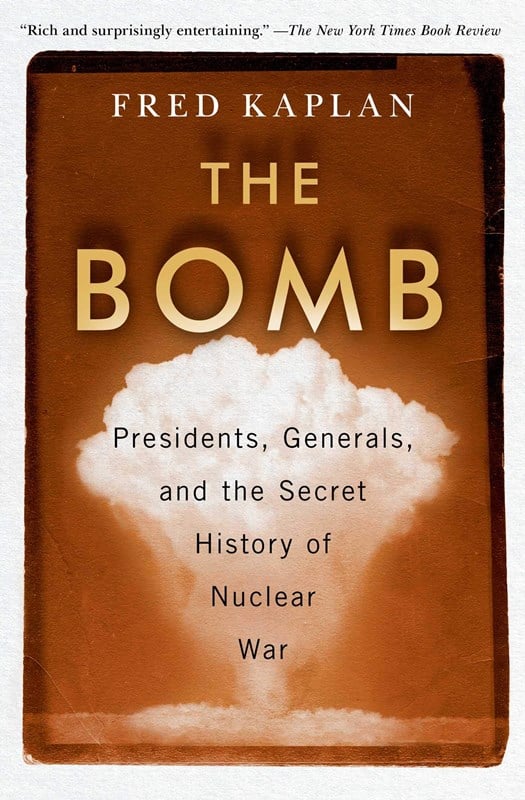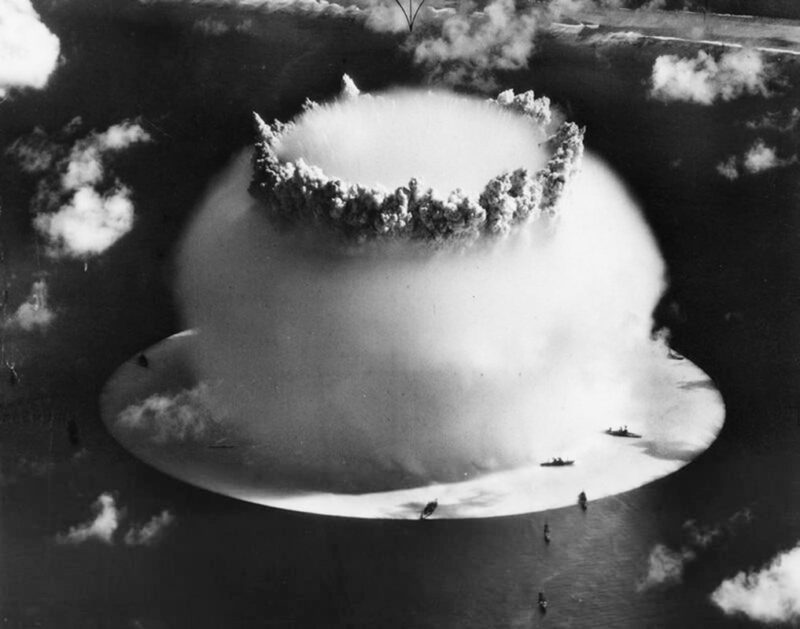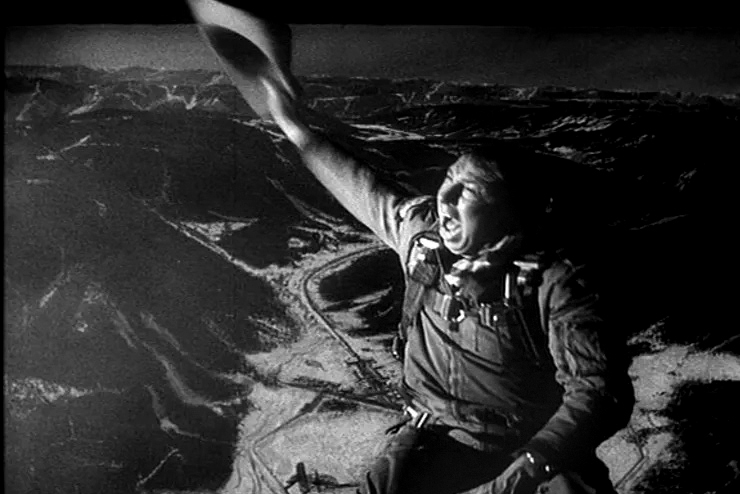The Bomb: Presidents, Generals, and the Secret History of Nuclear War; by Fred Kaplan; Simon & Schuster; 384 pp., $18.00
In 1958, former RAF officer Peter George (under the pseudonym Peter Bryant) wrote Red Alert, a novel about a communication accident that almost triggers a nuclear war. In a series of short, increasingly tense, time-stamped chapters, the novel shifts between the crew of an American bomber streaking toward its Russian target and the increasingly frantic military and political leaders in both the United States and the USSR trying to stop them.
Red Alert is a flawed and very brief piece of literature (curious readers can complete it between lunch and teatime on a Sunday afternoon), but it attracted attention in many serious circles. No less a personage than Thomas Schelling, whose The Strategy of Conflict (1960) made him one of the pioneers in the burgeoning field of nuclear strategy, reviewed the novel for the Bulletin of the Atomic Scientists as an example of the dangers of accidental escalation in the nuclear age.
George’s novel and Schelling’s review touched upon something in the early 1960s zeitgeist. It inspired Harvey Wheeler and Eugene Burdick to expand upon the theme in their own novel, Fail-Safe (1962). Equally serious and even more downbeat than Red Alert, though more tied to current events and personalities, Fail-Safe’s similarities led to dueling lawsuits alleging plagiarism.
George’s book also caught the eye of filmmaker Stanley Kubrick as he sought a theme for his follow-up to Spartacus. Kubrick was drawn to the apocalyptic dangers of the Bomb and the fragility of human control over a nuclear crisis. However, after immersing himself in the literature of nuclear strategy, Kubrick decided that the deadly seriousness of Red Alert failed to capture the absurd realities of planning for an apocalyptic war, which everyone claimed they did not want to fight, and which no one actually knew how to win. Thus his film, written with satirist Terry Southern, became the classic 1964 black comedy, Dr. Strangelove or: How I Learned to Stop Worrying and Love the Bomb.
The runaway success of Dr. Strangelove overshadowed the film version of Fail-Safe released later in that same year, and Strangelove has remained firmly embedded in the public consciousness ever since. This may simply reflect superior dramaturgy and the genius of Peter Sellers, but it also says something deeper about how the public understands the nuclear bomb.
Although there have been many films since that touch on the subject, most of which are as unavoidably downbeat as any story of the senseless destruction of mankind would be, one can’t quite shake the idea that the entire nuclear business is, to quote the childlike computer character in the 1983 film WarGames, a “strange game” where “the only winning move is not to play.”
 Fred Kaplan, who writes on nuclear issues for the online journal Slate and for other publications, has been studying the nuclear game for years. Kaplan made a name for himself nearly three decades ago with The Wizards of Armageddon (1983), which traced stories of nuclear strategists from Hiroshima to the Reagan era. Equal parts intellectual history and political exposé, that book earned respect from both historians and activists for its detailed discussion of the men and ideas that led us into the nuclear age. In his new book, The Bomb: Presidents, Generals, and the Secret History of Nuclear War, Kaplan goes over some familiar territory, but this time he is much more interested in how the often esoteric discussions of nuclear strategy influenced decision-making within the higher levels of the American government. The result is a detailed and fascinating history of a persistently interesting topic.
Fred Kaplan, who writes on nuclear issues for the online journal Slate and for other publications, has been studying the nuclear game for years. Kaplan made a name for himself nearly three decades ago with The Wizards of Armageddon (1983), which traced stories of nuclear strategists from Hiroshima to the Reagan era. Equal parts intellectual history and political exposé, that book earned respect from both historians and activists for its detailed discussion of the men and ideas that led us into the nuclear age. In his new book, The Bomb: Presidents, Generals, and the Secret History of Nuclear War, Kaplan goes over some familiar territory, but this time he is much more interested in how the often esoteric discussions of nuclear strategy influenced decision-making within the higher levels of the American government. The result is a detailed and fascinating history of a persistently interesting topic.
The first half of The Bomb focuses on internal debates between generals and civilian leaders in Washington, while the second half looks outward, to the discussion of arms control. This includes recent controversies on how best to limit the danger of nuclear weapons in the hands of North Korea or Iran. Throughout, Kaplan is clearly on the side of those who would like to see fewer arms and more control, and he is unsurprisingly critical of the “fire and fury” rhetoric of the early Trump administration.
At the same time, Kaplan is also honest enough to note that debates over nuclear policy and the role of the president as the ultimate decision maker predated Donald Trump, whom he calls “a symptom, not the cause, of our common nuclear problem.” The Founding Fathers “devised checks and balances to a potential autocrat’s power—a legislature, judiciary, free press, and (they hoped) an educated public,” Kaplan writes. American presidents have taken ultimate control of the Bomb away from the military because, as Harry Truman put it, “this isn’t a military weapon.” Yet, America remains disturbingly dependent on individual presidents to decide when, where, and how to use the ultimate weapon.
Kaplan’s style is analytical and cool, but he tells a story that is not free of the absurd and the depressing. One recurring theme is how every president since John F. Kennedy has entered office determined to get a clear sense of how many nuclear weapons are at his disposal and how they will be used, only to be shocked at just how much destruction any nuclear conflict would entail, once he is given a glimpse at the government’s vision of Armageddon, euphemistically known as the Single Integrated Operational Plan.
While every president and secretary of defense has requested a wider range of options, the Air Force generals who controlled Strategic Air Command (SAC) and its post-Cold War successor, Strategic Command, have preferred maximum coverage of the widest possible range of targets.
 For example, when SAC Commander Thomas Power briefed Secretary of Defense Robert McNamara in the early 1960s, Power explained the need to take out an air defense radar in Albania with multiple megatons, guaranteed to kill hundreds of thousands of civilians in a peripheral country politically independent of Moscow. “Mr. Secretary,” General Power said with a chuckle that shocked the usually unflappable McNamara, “I hope you don’t have any friends or relations in Albania, because we’re going to have to wipe it out.” Such gallows humor would not have surprised Kubrick.
For example, when SAC Commander Thomas Power briefed Secretary of Defense Robert McNamara in the early 1960s, Power explained the need to take out an air defense radar in Albania with multiple megatons, guaranteed to kill hundreds of thousands of civilians in a peripheral country politically independent of Moscow. “Mr. Secretary,” General Power said with a chuckle that shocked the usually unflappable McNamara, “I hope you don’t have any friends or relations in Albania, because we’re going to have to wipe it out.” Such gallows humor would not have surprised Kubrick.
As Kaplan tells it, every administration thus far has appeared surprised by the persistent presence of “overkill” in the American nuclear strategy. But the only thing more irresponsible than joking about megadeath would be evading the responsibility of national leaders to prepare for all possible contingencies. Kaplan traces the often repetitive debates over whether it would be possible or desirable to limit the targets of an initial nuclear attack, how one would or could keep a low-level nuclear exchange from escalating into an all-out “spasm war,” and even the probable circumstances within which an American president would cross the nuclear threshold in the first place.
“The generals and their aides have kept churning out war plans and calculating the consequences…spinning them in a way that might yield some kind of victory,” Kaplan concludes. “They have seen this as their job: to seek ways to make these weapons usable, in case the commander-in-chief wanted to use them.” However, Kaplan notes that the course of history thus far has shown that American presidents, when seriously weighing and discussing their options, have concluded that engaging in an exchange of nuclear weapons is far too risky a proposition, with consequences too enormous to sanction.
We are left with the central paradox of nuclear strategy: the need to plan a conflict whose result would make a grotesque mockery of all strategic plans. Concluding on a sober note, Kaplan quotes one of the first nuclear strategists, Bernard Brodie: “Everything about the atomic bomb is overshadowed by the twin facts that it exists and that its destructive power is fantastically great.” The story of the bomb therefore has been “the story of presidents and generals grappling with these twin facts, figuring out the best way to maneuver around them or to reconcile with them.”
That we have averted Armageddon thus far may be cause for relief, but it does not absolve current leaders or the public of the need to understand the continuing challenge of managing the Bomb. We have survived the first 75 years of the nuclear age, but the Bomb is still with us, giving us plenty of reasons to worry.
Image Credit:
Rogue B-52 bomber pilot Maj. “King” Kong (Slim Pickens) rides a nuclear bomb in flight in Stanley Kubrick’s 1964 film Dr. Strangelove or: How I learned to Stop Worrying and Love the Bomb (Columbia Pictures)

Leave a Reply